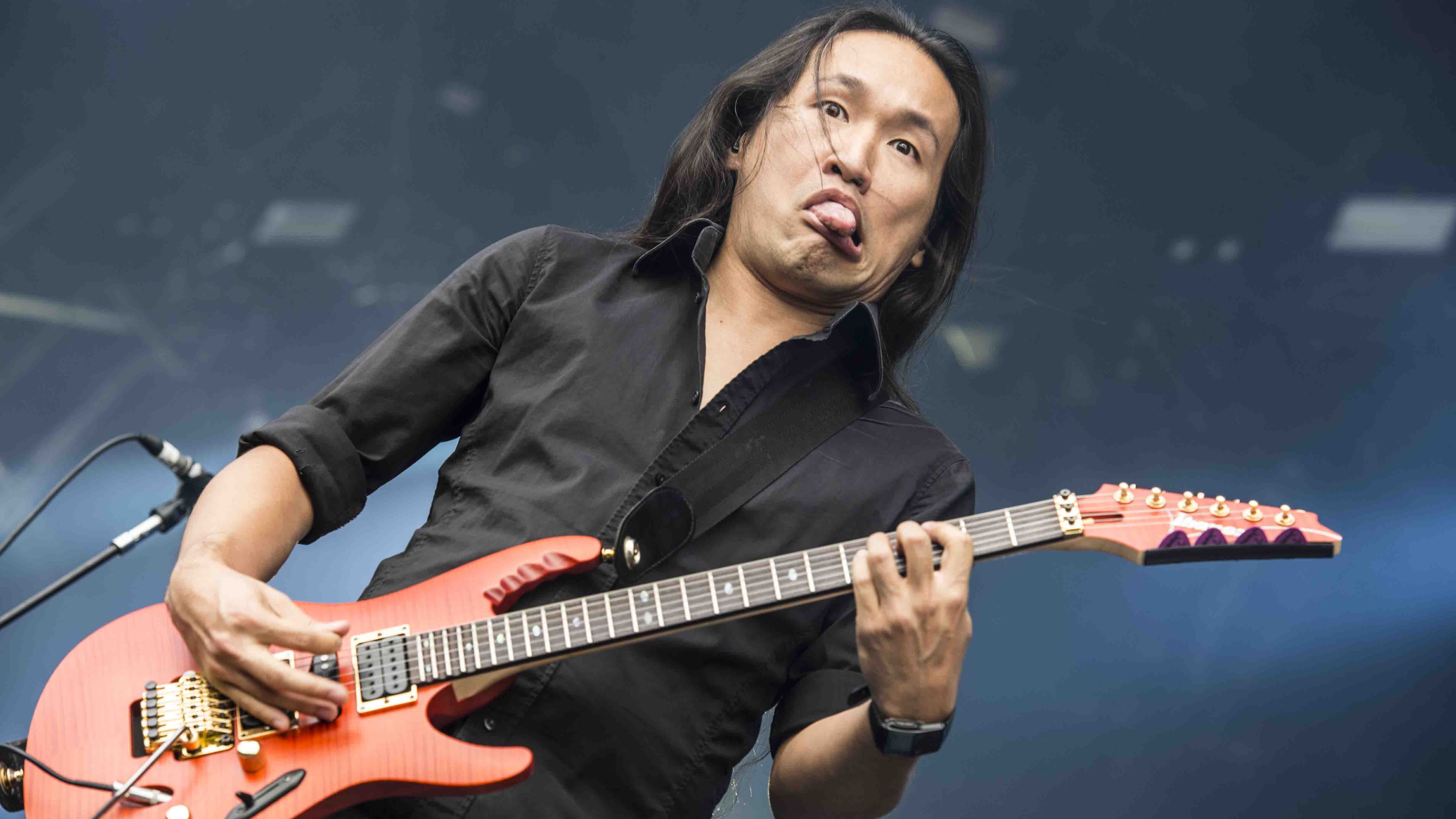DragonForce's Herman Li: my top 5 tips for guitarists
“Great vibrato is a high-level Jedi skill”

Reaching Into Infinity
When it comes to guitar acrobatics, few could rival DragonForce’s shredder-in-chief Herman Li. He’s the kind of player that’s dedicated countless hours of his life trying to make his guitar not sound like a guitar, as well as finding ways to impress the eyes as much as the ears.
It all comes from a very learned appreciation of music, stemming from early heroes like Steve Vai, John Petrucci and Joe Satriani, who taught him the importance of saying something meaningful, no matter how fast your fingers are moving.
“All the shredding stuff is great, but you have to consolidate it all to complete a solo,” muses the axeman, on a sunny afternoon in London’s East End.
Young players, especially metal players, are always so concerned with the sweeping and the tapping… but they forget great vibrato is a high-level Jedi skil
“That’s something all my favourite guitar players do to let you know they’ve finished this epic solo… we’re searching for that even more these days. Using slower bends with smooth vibrato is a newer technique for what I do in DragonForce, because most of our music has been compressed with a lot of notes… it’s important we try to find the right moments to have those singing notes.
“So I’d actually say some of the hardest techniques are bends and vibratos,” he notes. “Like learning circular vibrato and then trying something more wide or with a different timing… they all sound different. It’s not so much a new technique, but rather continual development.
“Young players, especially metal players, are always so concerned with the sweeping and the tapping… but they forget great vibrato is a high-level Jedi skill. That’s what brings your tone; it’s all about what your fingers are doing.”
With album number seven Reaching Into Infinity hitting shelves this month, Herman guides us through what gear was used for the recordings. It should come as no surprise that the only guitar you’ll hear him play is the Ibanez EGen signature that’s been seen his hands for well over a decade…
“I only use my signature guitar… all the time,” reveals Herman. “It feels right and sounds right to me. Other models are fun and challenging, but when I’m there to do my job, I want to be in the best mindset possible. So it’s always my own guitar, either a six or seven-string.
“It feels like there’s always a compromise between tone and playability. Some guitars will have a great tone but are too heavy or uncomfortable to use live. I chose to build a guitar that works in every way - it might not be the best studio guitar or live guitar, but it works great for everything. And that’s all I need. The more I play it, the more I understand it… and the wood seems to start sounding better.
“On the last tour, I started using a Kemper. I profiled my Rocktron Prophesy [preamp] so I could use the more up-to-date effects, like the harmonizer. Weirdly enough, I used the profiled versions to record the album - I chose the fake sounds over the real ones, probably because I couldn’t be bothered to unplug it all. It might not be 100% exactly perfect, but it’s the closest you can get with modern technology… and clearly close enough for me!”
Here, the virtuoso axeman gives us five tips for musical wisdom…

1. Play in total darkness!
“Put some music on and improvise with all the lights off so you can’t see the fretboard. I did this a lot when I was young - I would play standing up just improvising to anything I heard. That helped develop the feel of where the frets are and all the positions.
“Obviously if you change your guitar, say to a Flying V, everything would shift a bit. But most double cutaways are fairly similar - you can start sliding into position without looking. When I’m doing backing vocals on stage, for example, I don’t look at the guitar ever. I’ll only check it if I can’t hear things well enough.
“Remember things change when you’re playing live. Sweat will change the friction of the strings, which will affect you if you’re doing lots of slides. Use Fast Fret or something similar to make sure it’s super-clean to glide across. The friction plays a big part in the movement of finding the right notes. I was playing at Musikmesse not long ago and it was really hot and sweaty in this room. When the sweat started changing the friction, my fingers started getting a bit more stuck in places.”

2. Wear your guitar in a position that looks cool!
“No-one wants to see you playing with it strapped up to your neck. Maybe don’t have it Nuno Bettencourt-low, but a bit higher than the waist… remember the distance between your eyes and the frets has increased. Which makes it harder. The same goes for sweeping: the lower the guitar, the harder the angle will be.
“When you sit down to practise, you can see everything up close - but it’s different when you’re playing stood up on a stage. It comes down to hand-eye coordination and intuition when the distance between you and the fretboard is larger. It’s a case of finding the right balance…”

3. Learn to play a full solo holding the whammy bar in your hand…
“But without using it. The only way to do it is hold the pick with your thumb and one finger. Three fingers, like Steve Morse from Deep Purple, would not be possible. You need to hook the remaining three fingers around the whammy bar and play the entire solo with scoops and dives available.
“The trick is to not utilise the bar for anything until you’ve mastered the grip. Later, you can add your own pulls and swells into each note - that will give you the option to add lots of expression to anything you play.”

4. You can mute with the left hand, too!
“This is something no-one seems to teach. You hear a lot about right-hand muting, but I feel like left-hand muting is a forgotten art, especially when the whammy bar. When you grab the bar, you can mute with your hand but it’s not really exciting to see at a rock show… you want to see a player pulling and pushing the bar with all their might and using every limb they can!
“And the muting should really be done by the left hand at that stage. When I do my big whammy screams, I don’t have total control with my right-hand wrist… so the left hand steps up.
“I call all of these the wrong techniques… because they are things you learn from playing live. You can do everything by the book when sat down practising at home by yourself - it’s when you’re performing to people, you need to play a show, make it look impressive. The more you do it, the more automatic it becomes. The first time I saw this was when I got the Guitar Legends Live In Sevilla tape… I had no clue why Steve Vai’s left hand was doing all of that.”

5. Go out and party!
“Assuming all of you know the basics, the last thing is to learn how to party.
“Through that, you’ll learn how to make friends! Learn from other musicians by playing with them. When I first started, I didn’t really go out and have much fun. I did it way later on. It took a while to realise you need to know how to party in order to find the right musicians to play with.
Let’s get more guitar players outside and playing to inspire the new generation!
“People won’t teach you that, but isn’t music all about human interaction? Have a good time, get away from the guitar, find a band by going out partying. Some players never want to leave the bedroom - that’s totally fine, but the only way you find out what’s going on outside is by leaving the house. So let’s get more guitar players outside and playing to inspire the new generation!
“You learn a lot by being around people over the years. You learn how to work with others, whether it be bandmates or the crew. You can’t have everything your own way all the time. So go out, get drunk, talk about music and interact with people.”
Amit has been writing for titles like Total Guitar, MusicRadar and Guitar World for over a decade and counts Richie Kotzen, Guthrie Govan and Jeff Beck among his primary influences. He's interviewed everyone from Ozzy Osbourne and Lemmy to Slash and Jimmy Page, and once even traded solos with a member of Slayer on a track released internationally. As a session guitarist, he's played alongside members of Judas Priest and Uriah Heep in London ensemble Metalworks, as well as handling lead guitars for legends like Glen Matlock (Sex Pistols, The Faces) and Stu Hamm (Steve Vai, Joe Satriani, G3).
